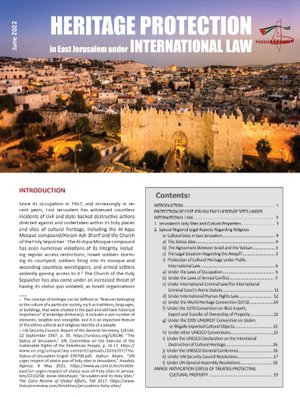Heritage Protection in East Jerusalem under International Law
Overview
Since its occupation in 1967, and increasingly in recent years, East Jerusalem has witnessed countless incidents of civil and state-backed destructive actions directed against and undertaken within its holy places and sites of cultural heritage, including the Al-Aqsa Mosque compound/Haram Ash-Sharif and the Church of the Holy Sepulcher. The Al-Aqsa Mosque compound has seen numerous violations of its integrity, including regular access restrictions, Israeli soldiers storming its courtyard, soldiers firing into its mosque and wounding countless worshippers, and armed settlers violently gaining access to it. The Church of the Holy Sepulcher has also come under an increased threat of having its status quo violated, as Israeli organizations use police forces to impede access, and the Israeli government has historically suggested it need not comply with its status quo in general. Apart from those two prominent sites, a large number of other religious or cultural locations within the Old City and East Jerusalem have faced increasing interference and desecration by the Israeli state and Israeli occupation municipality in Jerusalem since 1967. Sites are subject to unnecessarily cumbersome administrative regulations, high taxation, risk of collapse due to nearby construction activities, and the threat of property destruction and loss due to increased facilitation of confiscation by Israeli authorities. The numerous Israeli archaeological excavations do not only interfere with cultural heritage, but also endanger the stability of buildings and structures situated above the excavated area. Moreover, countless Palestinian antique artifacts and Islamic pieces of art, confiscated during the 1967 War, are displayed in Israeli museums.
None of these acts against religious and heritage sites or of cultural appropriation have been confronted or addressed by Israeli domestic legal mechanisms. While Israel considers East Jerusalem as a legitimate part of its territory, it does not provide for any legal protection regarding non-Jewish cultural heritage located there. Under domestic rule, Israel’s Protection of Holy Places Law and Antiquities Law protect cultural heritage and religious sites and ensure freedom of access to them. Yet, no definition of “holy” or “cultural site” exists. Instead, the laws include only an enumeration of protected property which includes 16 sacred places of Judaism and the Regulations for the Protection of Holy Places for Jews: a state approach that has not changed despite a 2004 petition to the Supreme Court regarding the lack of cultural protection for non-Jewish sites.
These events have raised the question of what the applicable protective legal framework is concerning Jerusalem’s holy and cultural sites under international law, especially in regards to East Jerusalem’s status as an occupied, historic, and religiously unique city. This bulletin will therefore focus on the current legal status that applies to East Jerusalem’s religious and cultural sites as well as the international laws and regulations governing the protection of heritage and cultural properties under occupation in general.

